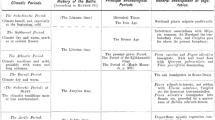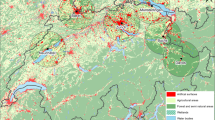Abstract
To test models predicting biological reponse to future climate change, it is essential to find climatically-sensitive, easily monitored biological indicators that respond to climate change. Routine monitoring of airborne pollen, now undertaken on a near-global basis, could be adapted for this purpose. Analysis of spatial and seasonal variations in pollen levels in New Zealand suggests that the timing of onset and peak abundance of certain pollen taxa should be explored as possible bio-indicators of climate change. The onset of the airborne grass pollen season during the summer of 1988/89 varied consistently with latitude, and hence temperature, with the season in Southland commencing 8--9 days after Northland. However, these patterns were only apparent after sampling sites were separated into two groups reflecting predominantly urban or rural pollen sources. A less consistent north to south trend was apparent in the frequency of high (30 grains/m3) grass pollen levels, with high levels frequent in North Island localities in November, December and January and in southern localities during December and January. The successive onset of pollen seasons for the principal tree species during the spring-to-early summer warming interval may also be a useful bio-indicator of climate change. As well as assisting forecasts of the onset of the pollinosis season, these biogeographical patterns, reflecting climatic variation with latitude, suggest that routine aeropalynological monitoring might provide early signals of vegetation response to climate change. These conclusions are supported by recent investigations of long-term aeropalynological datasets in Europe that indicate earlier onset of pollen seasons in response to recent global warming.
Similar content being viewed by others
References
Anderson T.B.: 1991, A model to predict the start of the pollen season. Grana 30, 269–275.
Birks H.J.B.: 1989, Holocene isochrone maps and patterns of tree spreading in the British Isles. Journal of Biogeography 16, 503–540.
Cannell M.G.R. and Pitcairn C.E.R.: 1993, Impacts of the Mild Winters and Hot Summers in the United Kingdom in 1988–1990. Dept. of the Environment, HMSO: London.
Dafni A.: 1992, Pollination Ecology: A Practical Approach. Oxford University Press: Oxford, UK.
Davis M.B.: 1981, Quaternary history and the stability of forest communities. In D.C. West, H.H. Shugart and D.B. Botkin (eds), Forest Succession. Springer-Verlag: New York, USA, pp. 132–153.
Decker W.L., Jones V.K. and Achutuni R.: 1986, The impact of climate change from increased atmospheric carbon dioxide on American agriculture. St Louis, University of Missouri, Report No. DoE/NBB-0077.
Driessen M.N.B., van Herpen R.M.A., Moelands R.F.M. and Spieksma F.Th.M.: 1989, Prediction of the start of the grass pollen season for the western part of the Netherlands. Grana 28, 37–44.
Dudek D.J.: 1991, The nexus of agriculture, environment, and the economy under climate change. In R.L. Wyman (ed), Global Climate Change and Life on Earth. Chapman & Hall: New York, pp. 180–200.
Emberlin J.: 1994, The effects of patterns in climate and pollen abundancy on allergy. Allergy 49, 15–20.
Emberlin J.C., Savage M. and Woodman R.: 1993, Annual variations in the concentration of Betula pollen in the London area, 1961–1990. Grana 32, 359–363.
Emberlin J., Jones S., Bailey J., Caulton E., Corden J., Dubbels S., Evans J., McDonagh N., Millington W., Mullins J., Russel R. and Spencer A.: 1994, Variation in the start of the grass pollen season at selected sites in the United Kingdom 1987–1992. Grana 33, 94–99.
Ford M.J.: 1982, The Changing Climate: Response of the Natural Flora and Fauna. Allen & Unwin: London.
Frenguelli G., Bricchi E., Romano B., Mincigrucci G. and Spieksma F.Th.M.: 1989, A predictive study on the beginning of the pollen season for Gramineae and Olea europea. L., Aerobiologia 5, 64–70.
Frenguelli G., Spieksma F.Th.M., Bricchi E., Romano B., Mincigrucci G., Nikkels A.H., Dankaart W. and Ferranti F.: 1991, The influence of air temperature on the starting dates of the pollen season of Alnus and Populus. Grana 30, 196–200.
Groot R.S. de, Ketner P. and Ovaa A.H.: 1995, Selection and use of bio-indicators to assess the possible effects of climate change in Europe. Journal of Biogeography 22, 935–943.
Henderson-Sellers A.: 1991, Policy advice on greenhouse-induced climatic change: the scientist's dilemna. Progress in Physical Geography 15, 53–70.
Henderson-Sellers A.: 1994, Numerical modelling of global climates. In N. Roberts (ed), The Changing Global Environment. Blackwell: Oxford, pp. 99–124.
Houghton J.T., Callendar B.A. and Varney S.K.: 1992, Climate Change 1992: The Supplementary Report to the IPCC Scientific Assessment. Cambridge University Press: Cambridge.
Kenny G.J., Warrick R.A., Mitchell N.D., Mullan A.B. and Salinger M.J.: 1995, CLIMPACTS: an integrated model for assessment of the effects of climate change on the New Zealand environment. Journal of Biogeography 22, 883–895.
McGlone M.S.: 1985, Plant biogeography and the late Cenozoic history of New Zealand. New Zealand Journal of Botany 23, 723–749.
Moffatt I.: 1991, Possible ecological impacts of the greenhouse effect on the Northern Territory, Australia. Global Ecology and Biogeography Newsletters 1, 102–107.
New Zealand Official Yearbook: 1988/89, Wellington, Govt. Printer.
Newnham R.M., Fountain D.W., Cornford C. and Forde M.B.: 1995a, A national survey of airborne pollen and grass flowering in New Zealand with implications for respiratory disorder. Aerobiologia 11, 239–252.
Newnham R.M., de Lange P.J. and Lowe D.J.: 1995b, Holocene vegetation, climate and history of a raised-bog complex, northern New Zealand, from pollen, plant macrofossils, and tephrochronological investigations. The Holocene 5, 267–282.
Newnham R.M., Lowe D.J., Green J.D.: 1989, Palynology, vegetation and climate of the Waikato lowlands, North Island, New Zealand, since c. 18,000 years ago. Journal of the Royal Society of New Zealand 19, 127–150.
Parr T. and Eatherall A.: 1994, Demonstrating Climate Change Impacts in the UK: The DoE Core Model Programme. Dept. of the Environment: London.
Parry M.S.: 1985, The impact of climate variations on agriculture margins. In R.W. Kates, J.H. Ausubel and M. Berberian (ed), Climate Impact Assessment: Studies of the Interaction of Climate and Society, Scope 27. John Wiley: New York, pp. 351–367.
Parry M.S.: 1990, Climate Change and World Agriculture. Earthscan: London.
Parry M.S., Carter T.R. and Konijn N.T.: 1988, The Impact of Climate Variations on Agriculture, Volume 1: Assessment in Cool Temperate and Cold Regions. Kluwer Academic Publishers: Norwall, MA.
Salinger M.J.: 1987, Impact of climatic warming on the New Zealand growing season. Journal of the Royal Society of New Zealand 17, 363–371.
Solomon A.M.: 1986, Transient response of forests to CO2-induced climate change: Simulation modelling experiments in eastern North America. Oecologia 68, 567–579.
Solomon A.M. and Leemans R.: 1990, Climate change and landscape ecological response: issues and analyses. In M.M. Boer and R.S. de Grouf (eds) Landscape Ecological Impact and Climate Change. IOS Press: Amsterdam.
Spieksma F.Th.M., Emberlin J.C., Hjelmroos M., Jager S. and Leuschner R.M.: 1995, Atmospheric birch (Betula) pollen in Europe: Trends and fluctuations in annual quantities and the starting dates of the seasons. Grana 34, 51–57.
Stevenson A.C. and Newson M.: 1992, Natural environments of the future: adapting, conserving, restoring. In M. Newson (ed), Managing the Human Impact on the Natural Environment: patterns and processes. Belhaven: London, pp. 287–303.
Stott P.: 1994, Savannah landscapes and global environmental change. In N. Roberts (ed), The Changing Global Environment. Blackwell: Oxford, pp. 99–124.
Tivy J.: 1993, Biogeography: A Study of Plants in the Ecosphere. 3rd edn, Longman: Harlow.
Wardle P.: 1988, Effects of glacial climates on floristic distribution in New Zealand. 1. A review of the evidence. New Zealand Journal of Botany 26, 541–555.
Wards I.: 1976, New Zealand Atlas. A.R. Shearer, Govt. Printer: Wellington.
Wyman R.L.: 1991, Global Climate Change and Life on Earth. Chapman & Hall: New York.
Author information
Authors and Affiliations
Rights and permissions
About this article
Cite this article
Newnham, R.M. Monitoring biogeographical response to climate change: The potential role of aeropalynology. Aerobiologia 15, 87–94 (1999). https://doi.org/10.1023/A:1007595615115
Issue Date:
DOI: https://doi.org/10.1023/A:1007595615115




